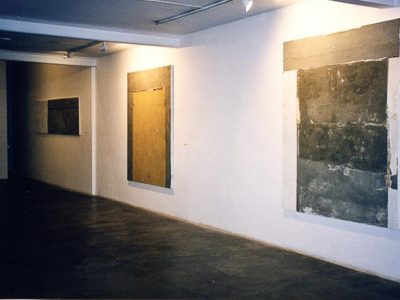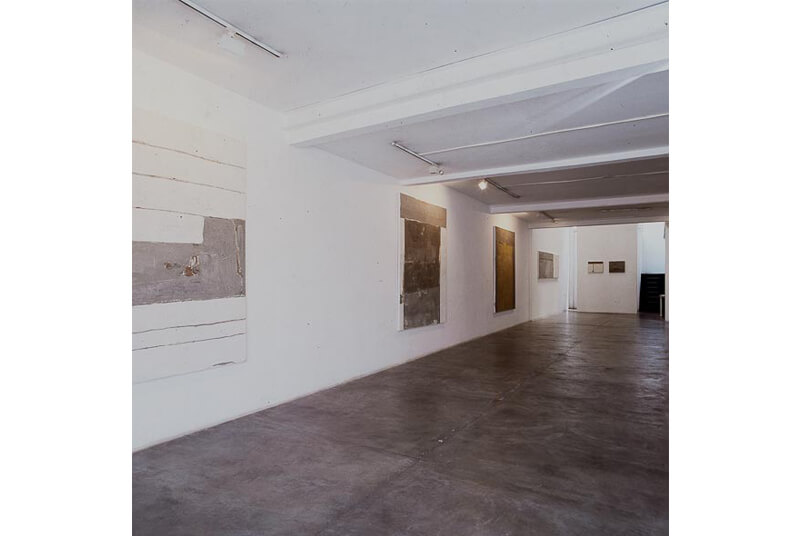A Pintura Depois do Fim da Pintura
A PINTURA DEPOIS DO FIM DA PINTURA
Paulo Sergio Duarte, Rio de Janeiro, Novembro de 1999
A pintura está próxima, muito próxima. Mal posso olhá-la. O trabalho eliminou a distância, e encosta o olho na superfície, como se fosse possível a aberração de um Van Gogh sem cor. A pintura, tão próxima, recua. Vaza o suporte e encosta na parede. Incorpora a parede e ao tomar conta desta parece reduzi-la à memória de uma ruína.
Ou, caso queira-se, pode-se imaginar o movimento inverso. Transformado em quadro e depois de cinco séculos de desprezo pela origem, retorna o suporte onde nasceu – o primeiro – recalcado, a parede, que toma conta brutalmente da superfície. Mas este já não se encontra no estado original quando esteve preparado para receber as primeiras camadas de tintas de afresco ou mural. É a própria imagem do abandono.
Ana Muglia trabalha e promove essa simbiose impossível entre plano e superfície criando uma situação onde o plano idealizado, entidade geométrica construída se confronta com a superfície, realidade empírica, palco real da atividade do pintor. Deste embate, vê-se logo, sai vitoriosa a superfície. E não poderia ser de outro modo porque uma história se impõe e não há mais lugar para mediações utópicas de uma ordem ideal euclideana e seus procedimentos íntimos da razão pura. O triunfo da realidade empírica, de suas exigências e de seus procedimentos sem máscaras é conquista do mundo e desnorteia todas as regras traçadas a priori. Por isso essa presença crua dos materiais como testemunhos de momentos sucessivos de constituição do trabalho que são chamados a conviver na superfície expondo o conflito.
Mas, notem, apesar da violência da disputa, que implica em fazer conviver cimento, ferro, tijolos, enfim, materiais duros e secos do muro, e pintura, no volume restrito do quadro, tudo se realiza com certo pudor, numa luta sem gritos e uivos, em surdina, entre a escultura plana e a pintura com volume. Ou, talvez, como representação de forças que não necessitam da extravagância e da eloquência para apresentar a cena mínima de seu teatro discreto: a pintura depois do fim da pintura.
THE PAINTING AFTER END OF PAINTING
Paulo Sergio Duarte, Rio de Janeiro, November 1999
The painting is close, too close. I can hardly look at it. The work has eliminated the distance and made the eye touch the surface if the aberration of a colorless Van Gogh were possible. The painting, so close, moves back. it breaks through the support and leans against the wall. It embodies the wall, which is seized by it and reduced to the memory of a ruin.
Or, as one mau prefer, the inverse movement can be perceived. Made into a picture and after five centuries of despise for its origin, the support is back to its birthplace – the first one – repressed, the wall, which seizes the surface. But it does not represent its original state when it was prepared to get the first layers of paint of fresco or wall painting. It is the very image of abandonment.
Ana Muglia works and promotes this impossible symbiosis between plan and surface resulting a situation where the idealized plan, a built geometric entity, is faced with the surface, empirical reality, wich is the real stage of the painter’s activity. From this struggle, you can clearly see, the surface is the winner. And it could not be otherwise because since a history is imposed and does not let tutopian mediations of an ideal Euclidean order and its intimate procedures of pure reasoning. The triumph of the empirical reality, of its and of its unmasked procedures, is the world’s conquest and bewilders all a priori laid down rules. That is why this raw presence of materials as witnesses of successive moments of building up the work are sharing the surface to show the conflic.
But it can be noticed that despite of the violence that makes cement, iron, bricks, at least, hard and dry materials of the wall combine with painting, in the restrictive volume of the picture, everything is accomplished prudisly, in a battle without screams and representation of strengh, that needs not extravagance and eloquence to present the minimum scene of its discrete theater play; the painting after the end of painting.




